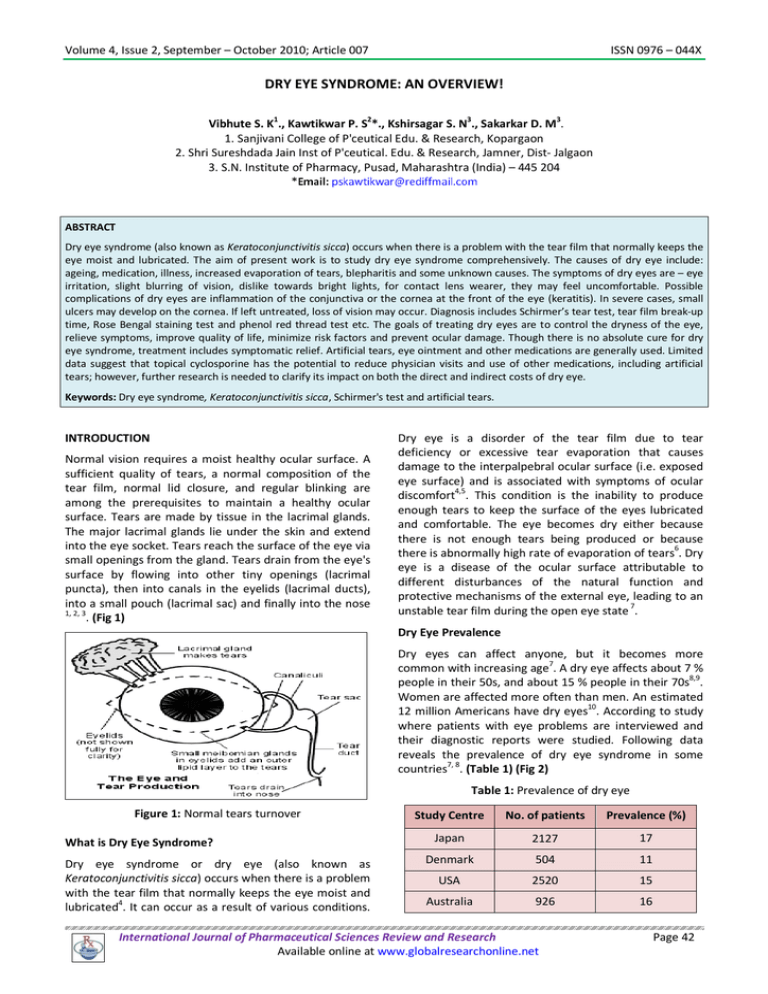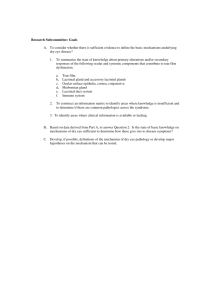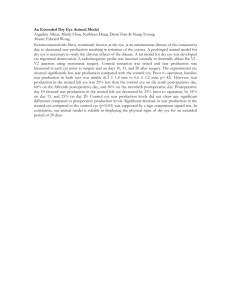Document 13308248
advertisement

Volume 4, Issue 2, September – October 2010; Article 007
ISSN 0976 – 044X
DRY EYE SYNDROME: AN OVERVIEW!
Vibhute S. K1., Kawtikwar P. S2*., Kshirsagar S. N3., Sakarkar D. M3.
1. Sanjivani College of P'ceutical Edu. & Research, Kopargaon
2. Shri Sureshdada Jain Inst of P'ceutical. Edu. & Research, Jamner, Dist- Jalgaon
3. S.N. Institute of Pharmacy, Pusad, Maharashtra (India) – 445 204
ABSTRACT
Dry eye syndrome (also known as Keratoconjunctivitis sicca) occurs when there is a problem with the tear film that normally keeps the
eye moist and lubricated. The aim of present work is to study dry eye syndrome comprehensively. The causes of dry eye include:
ageing, medication, illness, increased evaporation of tears, blepharitis and some unknown causes. The symptoms of dry eyes are – eye
irritation, slight blurring of vision, dislike towards bright lights, for contact lens wearer, they may feel uncomfortable. Possible
complications of dry eyes are inflammation of the conjunctiva or the cornea at the front of the eye (keratitis). In severe cases, small
ulcers may develop on the cornea. If left untreated, loss of vision may occur. Diagnosis includes Schirmer’s tear test, tear film break-up
time, Rose Bengal staining test and phenol red thread test etc. The goals of treating dry eyes are to control the dryness of the eye,
relieve symptoms, improve quality of life, minimize risk factors and prevent ocular damage. Though there is no absolute cure for dry
eye syndrome, treatment includes symptomatic relief. Artificial tears, eye ointment and other medications are generally used. Limited
data suggest that topical cyclosporine has the potential to reduce physician visits and use of other medications, including artificial
tears; however, further research is needed to clarify its impact on both the direct and indirect costs of dry eye.
Keywords: Dry eye syndrome, Keratoconjunctivitis sicca, Schirmer's test and artificial tears.
INTRODUCTION
Normal vision requires a moist healthy ocular surface. A
sufficient quality of tears, a normal composition of the
tear film, normal lid closure, and regular blinking are
among the prerequisites to maintain a healthy ocular
surface. Tears are made by tissue in the lacrimal glands.
The major lacrimal glands lie under the skin and extend
into the eye socket. Tears reach the surface of the eye via
small openings from the gland. Tears drain from the eye's
surface by flowing into other tiny openings (lacrimal
puncta), then into canals in the eyelids (lacrimal ducts),
into a small pouch (lacrimal sac) and finally into the nose
1, 2, 3
. (Fig 1)
Dry eye is a disorder of the tear film due to tear
deficiency or excessive tear evaporation that causes
damage to the interpalpebral ocular surface (i.e. exposed
eye surface) and is associated with symptoms of ocular
discomfort4,5. This condition is the inability to produce
enough tears to keep the surface of the eyes lubricated
and comfortable. The eye becomes dry either because
there is not enough tears being produced or because
there is abnormally high rate of evaporation of tears6. Dry
eye is a disease of the ocular surface attributable to
different disturbances of the natural function and
protective mechanisms of the external eye, leading to an
7
unstable tear film during the open eye state .
Dry Eye Prevalence
Dry eyes can affect anyone, but it becomes more
7
common with increasing age . A dry eye affects about 7 %
8,9
people in their 50s, and about 15 % people in their 70s .
Women are affected more often than men. An estimated
12 million Americans have dry eyes10. According to study
where patients with eye problems are interviewed and
their diagnostic reports were studied. Following data
reveals the prevalence of dry eye syndrome in some
countries7, 8. (Table 1) (Fig 2)
Table 1: Prevalence of dry eye
Figure 1: Normal tears turnover
What is Dry Eye Syndrome?
Dry eye syndrome or dry eye (also known as
Keratoconjunctivitis sicca) occurs when there is a problem
with the tear film that normally keeps the eye moist and
lubricated4. It can occur as a result of various conditions.
Study Centre
No. of patients
Prevalence (%)
Japan
2127
17
Denmark
504
11
USA
2520
15
Australia
926
16
International Journal of Pharmaceutical Sciences Review and Research
Available online at www.globalresearchonline.net
Page 42
Volume 4, Issue 2, September – October 2010; Article 007
ISSN 0976 – 044X
Dry eye may be sight threatening
When serious complications occur there is danger of loss
of eyesight. In case of bacterial keratitis and corneal ulcer
there are great chances of blindness, hence it is advised
to take utmost care in such complications8. (Fig 3 & 4)
Figure 2: Prevalence of dry eye
Increasing prevalence of dry eye8, 11
Increasing life span of the population
Expansion of consumption of medications
Increase in number of people wearing contact
lenses
Increase in computer usage
Increase in number of patients undergoing LASIK
Figure 3: Corneal ulcer
Symptoms12, 13, 14
Irritation
Redness
Burning/ Stinging
Itchy eyes
Sandy- gritty feeling (foreign body sensation)
Blurred vision
Dry eye is classified into two major categories viz.
Evaporative Dry Eye and Tear-Deficient Dry Eye. In first
category there is excess evaporation of tear film causing
Dry Eye and there is less production and /or secretion of
tear in later. (Table 2)
Tearing
Dry Eye: Main Causes15, 16, 17, 18
Contact lens intolerance
Increased frequency of blinking
Mucous discharge
Photophobia (less frequent symptom)
Symptoms worsen in windy or air-conditioned
environments as day progresses after prolonged
reading, working on computers
Figure 4: Bacterial keratitis
Classification of Dry Eye4
Ageing: People tend to make fewer tears, as they get
older. In particular, some women notice dry eyes
developing after the menopause.
Medication: Some drugs sometimes have a side
effect of causing dry eyes or make dry eyes worse.
These include: diuretics ('water tablets'), some
antidepressants, antihistamines, some treatments for
anxiety and other psychological problems, the
contraceptive pill, beta-blockers such as propranolol,
atenolol etc; some eye drops used to treat other eye
conditions. This is not an exhaustive list.
Illness: Some people develop dry eyes as a symptom
of a more general disease. For example, dry eyes may
occur with rheumatoid arthritis, systemic lupus
erythematosus and Sjogren's syndrome. In these
situations patients would normally have other
symptoms in other parts of the body. For example,
joint pains. Meibomian gland disease is also
important cause of dry eye.
Possible complications
Complications are uncommon. Inflammation of the
conjunctiva (conjunctivitis) or the cornea at the front of
the eye (keratitis) sometimes occurs. In severe cases,
small ulcers may develop on the cornea. Rarely, the
corneal tissue may perforate (puncture). Eyes become red
or vision may be affected (more than slight temporary
blurring). In some cases eye pain develops other than the
grittiness or irritation that goes with dry eyes. These are
not normally symptoms of dry eyes and may indicate
another eye condition or a complication of dry eyes7.
International Journal of Pharmaceutical Sciences Review and Research
Available online at www.globalresearchonline.net
Page 43
Volume 4, Issue 2, September – October 2010; Article 007
ISSN 0976 – 044X
thyroid disease. Also, some people sleep with
their eyes partly open.
Increased evaporation of tears: This may be due to:
Low humidity. For example, from central heating
or air conditioning.
Low blink rate, often combined with opening
eyes wider than normal. For example, spending a
long time looking at a computer, TV or
microscope.
Windy conditions when you are outside.
Inability to completely cover the eyes when
closing the eyelids. For example, due to eye
problems that some people have related to
Damage to the outer part of the eyes, eyelids, etc,
from disease, injury or surgery.
Blepharitis (inflammation of the eyelids) is often
associated with dry eyes.
Unknown: Some younger people have no apparent
cause. They simply produce less than the normal
amount of tears.
Table 2: Dry eye classification
Evaporative Dry Eye
Environmental factors
Eyelid Inflammation
Lid surfacing anomalies
Tear-Deficient Dry Eye
Sjogren’s syndrome
(dry eye + dry mouth + arthritis)
Non-Sjogren’s syndrome
Central heating (forced air dry heat), hair dryer, car windscreen demisting,
air travel, dry climates, wind, air pollution (cigarette smoke), contact lens
wear (reduced blinking), driving, watching TV, computer work, reading.
Blepharitis, rosacea & meibomian gland dysfunction are major causes of
this form of dry eyes.
Tears are not spread adequately over the eye surface due to proptosis,
ectropion, entropion, nocturnal
lagophthalmos, Bell's palsy,
pterygium/pingecula, conjunctivalchalsis.
Patients with Sjogren’s syndrome not only have dry eyes but also have dry
mouth. Blood tests show the presence of several antibodies (SS-A or SS-B,
ANA and RF). Connective tissue diseases (Rheumatoid arthritis, lupus etc)
may also be present.
Patients with non-Sjogren’s dry eyes do not produce tears because of a
disease of the tear gland. Examples of diseases that can cause dry eye in
this fashion include: sarcoidosis, Vitamin A deficiency, trachoma and
trauma. Chronic contact lens wear, past herpes eye infection, diabetes and
aging are other causes.
Dry eye diagnostic tests6, 18, 19, 20, 21, 22
There are various diagnostic methods for dry eye. These
methods are used to study the tear secretion, tear film
integrity, and tear stability, physical as well as chemical
composition of tear and histological study. Following are
some important diagnostic tests for dry eye.
1.
Tear film break-up test
This is used to find out the stability/instability of tear film
in all different causes of dry eye. It may be invasive with
fluorescein and non-invasive with toposcope. Here time
required for breaking the tear film is determined. In
severe dry eye it is minimal.
Values of < 10 seconds are considered abnormal
Values of 5-9 seconds are borderline dry eye
Values of < 5 seconds are clearly indicative of dry eye
(Fig 5)
2. Fluorescein clearance test
Figure 5: Tear break up- time test
Tear turnover is important for removing inflammatory
cytokines providing fresh supply of growth factors.
Delayed clearance of tears from the eye is thought to be a
contributing factor in pathogenesis of dry eye. Delay tear
clearance strongly correlates with ocular irritation
symptoms independent of aqueous tear production.
Standardized amount of fluorescein is placed in
conjunctival sac and tear turnover rate is determined by
persistent of fluorescein in tears at specific time points
later
International Journal of Pharmaceutical Sciences Review and Research
Available online at www.globalresearchonline.net
Page 44
Volume 4, Issue 2, September – October 2010; Article 007
3. Tear film Osmolarity
In dry eye tear film is in a hyperosmolar state due to
decrease production of tear, decrease lipid content of
tear, decreased film stability and increased evaporation
of tear film. A commercial osmometer specifically
designed to test nanometer volume of tear is now in use
but is not widespread due to cost consideration
ISSN 0976 – 044X
stains more intensity than the cornea. The intensity of
rose Bengal staining correlates well with the degree of
aqueous tear deficiency. (Fig 7)
Normal value for tear Osmolarity = 300-310 mOsm/l
4. Secondary tests to determine the specific causes of
the dry eye
There are certain diagnostic tests, which are used to
determine specific causes of the dry eye. Such tests are
Schirmer’s test, diagnostic dye staining, nasolacrimal
reflex, meibomian gland evaluation, impression cytology
and tear protein analysis etc. Among these tests
Schirmer’s test is widely used.
A. Schirmer’s test: The most commonly used technique
for assessment of tear secretion described in 1903 by a
German ophthalmologist Otto Schirmer. The Schirmer
strip is placed over the lateral third of the lower lid. If
using an anesthetic, adequate time should be given after
the drop to minimize reflex tearing from the burning
sensation due to drop. Schirmer’s test is performed with
and without anesthesia.
Schirmer I (without anesthesia): It determines the
basic and reflex secretion
Schirmer II (with anesthesia): It determines only
basic secretion
<5mm wetting in 5 min is sign of clinical dry eye
5-10mm wetting suggests borderline dry eye
>10mm wetting represents normal secretion
(Fig 6)
Figure 7: Rose Bengal staining
Lissamine green B similarly stains with Rose Bengal.
Produces much less irritation
Staining pattern identical to Rose Bengal
When score >5 indicated diagnosis of Sjogren’s
syndrome
23, 24, 25
Treatment/Management for dry eye syndrome
The goals of treating dry eyes are to control the dryness
of the eye, relieve symptoms, improve quality of life,
minimize risk factors and prevent ocular damage. Though
dry eyes cannot be cured, there are a number of steps
that can be taken to treat them. Treatments for dry eyes
may include:
Artificial tear drops and ointments: The use of artificial
teardrops is the primary treatment for dry eye. Artificial
teardrops are available over the counter in many
countries. No one drop works for everyone, so one has to
experiment to find the drop that works for him. In chronic
dry eye, it is important to use the drops even when your
eyes feel fine, to keep them lubricated. If eyes dry out
even while sleep, use of a thicker lubricant, such as an
ointment, at night is necessary.
Temporary punctal occlusion: Sometimes it is necessary
to close the ducts that drain tears out of the eye. This is
done via a painless procedure where a plug that will
dissolve quickly is inserted into the tear drain of the lower
eyelid. This is a temporary procedure, done to determine
whether permanent plugs can provide an adequate
supply of tears.
Figure 6: Schirmer’s test
B. Diagnostic dye staining: The installation of dyes is a
common method to detect ocular surface epithelial
pathology associated by dry eye. Dyes like Fluorescein
sodium, Rose Bengal, lissamine green are commonly
used.
Fluorescein is the most commonly used dye, which stains
the cornea more than conjunctiva. Significantly greater
amount of staining observed in Sjogren’s aqueous tear
deficiency.
Permanent punctal occlusion: If temporary plugging of
the tear drains works well, then silicone plugs (punctal
occlusion) may be used. The plugs will hold tears around
the eyes as long as they are in place. They can be
removed. Rarely, the plugs may come out spontaneously
or migrate down the tear drain. Many patients find that
the plugs improve comfort and reduce the need for
artificial tears.
Restasis: In 2002, the USFDA approved the prescription
eye drop Restasis (containing cyclosporine A) for the
treatment of chronic dry eye. It is currently the only
Rose Bengal unlike fluorescein, which stains tissue by
penetrating into intercellular spaces. Conjunctiva usually
International Journal of Pharmaceutical Sciences Review and Research
Available online at www.globalresearchonline.net
Page 45
Volume 4, Issue 2, September – October 2010; Article 007
ISSN 0976 – 044X
prescription eye drop that helps eyes to increase their
own tear production with continued use.
Limited data suggest that topical cyclosporine has the
potential to reduce physician visits and use of other
medications, including artificial tears; however, further
research is needed to clarify its impact on both the direct
and indirect costs of DED.
Other medications: Other medications, including topical
steroids, secretagogues may also be beneficial in some
cases.
Surgery: If needed, the ducts that drain tears into the
nose can be permanently closed to allow more tears to
remain around the eye. This is done with local anesthetic
on an outpatient basis. There are no limitations in activity
after having this surgery.
Among above options tear substitutes have certain
benefits. The composition of tear substitutes has great
resemblance with natural tears, hence they are popularly
known as ‘Artificial tears’.
Tear substitutes benefits 25, 26
Tear substitutes are the mainstay of therapy for dry eye.
CONCLUSION
Dry eye syndrome has significant prevalence around the
globe. Female and elderly persons are more affected than
other groups. There are various reasons for dry eye; most.
The diagnosis for dry eye includes different tests such as
tear film break-up tests, Schirmer’s test, rose Bengal
staining test, phenol red thread tests etc. Artificial tear
drops and ointments, temporary/permanent punctal
occlusion and other medication like topical steroids and
Restasis are used for the treatment of dry eye syndrome.
Artificial tears are most common and popular among
ophthalmologists as well as patients. Dry eye presents
important economic challenges to patients, physicians,
and health care delivery organizations. Emerging scientific
knowledge about dry eye may prompt payers or the
government to conduct comprehensive data analyses of
the economic impact of dry eye.
Provide adequate relief
Increase humidity at the ocular surface and
improve lubrication.
Smooth the ocular surface leading to improved
vision.
Intra/post-operative use has shown to help
restore ocular surface after refractive surgery.
1.
Clinical Knowledge Summaries, Dry eye syndrome
(March 2008), www.patient-pharmacy.co.uk
Improve patients’ quality of life.
2.
Dry Eye, Eye Facts, The Eye Digest, www.uic.edu.
3.
Dry
Eyes,
dry
www.agingeye.net
4.
The Eye Digest, University of Illinois Eye & Ear
Infirmary, Chicago, IL. www.agingeye.net, Page
Reviewed 17/06/2007
5.
Keratoconjunctivitis sicca, eMedicine. WebMD, Inc.
(21/042006). Retrieved on 11-12-2006.
6.
Dry
Eye
Institute
institute.org/holly.html
7.
Brewitt H, Sistani F, Dry eye disease: the scale of the
problem Surv Ophthalmol 2001; 45, Suppl 2:S199-202
8.
Suppl P & T, 2003; 28 (12) 1-45.
9.
Lee AJ, Lee J, Saw SM, Gazzard G, Koh D, Widjaja D.
and Tan DTH, Prevalence and risk factors associated
with dry eye symptoms: A population based study in
Indonesia, Br J Ophthalmol., Dec 2002; 86: 1347 –
1351.
Economic implications
17
Relatively few data exist on direct and indirect costs of
dry eye and its sequelae. Likely, this is due to the fact that
until recently, when the etiology of this common disease
became more fully understood, dry eye was viewed
largely as an irritant and not necessarily a serious
condition worthy of medical attention. Emerging scientific
knowledge about dry eye may prompt payers or the
government to conduct comprehensive data analyses of
the economic impact of dry eye. There are significant
comorbidities, associated diseases, and behavioral and
environmental factors that may contribute to the severity
of dry eye. Dry eye syndrome has significant economic
implications, including costs associated with increased
health care utilization, missed school and work, and
leisure and quality-of-life issues. Dry eye presents
important economic challenges to patients, physicians,
and health care delivery organizations. Data from a large
US managed care database suggest that the prevalence of
clinically diagnosed dry eye disease (DED) is 0.4% to 0.5%
overall, and is highest among women and the elderly. The
burden of DED to the patient can be substantial,
impacting visual function, daily activities, social and
physical functioning, workplace productivity, and quality
of life (QOL). Preliminary analysis suggests that DED also
has a considerable economic impact in terms of both
direct and indirect costs. A number of therapies have
been shown to improve DED signs and symptoms, but few
clinical trials have addressed QOL and economic issues.
REFERENCES
eye
information
website:
centre,
www.dry-eye-
10. Dry eyes, MedlinePlus Medical Encyclopedia. U.S.
National Library of Medicine (10-04-2006). Retrieved
on 16/11/2006
11. Anzaar F, Foster CS, Ekong AS, Dry eye syndrome,
eMedicine, August 2006,
www.patientpharmacy.co.uk.
12. Mackie IA, and Seal DV, The questionably dry eye, Br.
J. Ophthalmol, Jan 1981; 65: 2 – 9.
International Journal of Pharmaceutical Sciences Review and Research
Available online at www.globalresearchonline.net
Page 46
Volume 4, Issue 2, September – October 2010; Article 007
ISSN 0976 – 044X
13. Daniel NJ, Dry eye, Br J Ophthalmol, Jun 1997; 81:
426.
20. Tabbara KF, Sharara N, Dry eye syndrome, Drugs
Today (Barc) Am J Ophthalmol, 1998; 34:447-53.
14. The dry eye? Br J Ophthalmol, Jan 1981; 65: 1.
21. Bijsveld OP,Diagnostic tests in the sicca syndrome,
Arch Ophthalmol 1969,82: 10-24.
15. Sundecka M, Baryluk A, Polz dacewicz M, Prevalence
and risk factors of dry eye syndrome, Przegl
Epidemiol,Am J Ophthalmol, 2004; 58:227-33.
16. Dry eye syndrome affects quality of life or nearly 5
million in the US,
www.medicalnews.com, page
retrieved on 14/03/2007.
17. Pflufelder
S,
Prevalence,
burden
and
pharmacoeconomics of dry eye disease Am Manag
Care. 2008;14:S102-S106.
18. Fujishima H, Toda I, Shimazaki J, and Tsubota K,
Allergic conjunctivitis and dry eye, Br J Ophthalmol,
Nov 1996; 80: 994 – 997.
19. Moore JE, Graham JE, Goodall EA, Dartt DA, Leccisotti
A, McGilligan VE, Moor TCB, Concordance between
common dry eye diagnostic test, Br J Ophthalmol, Jan
2009; 93: 66-72.
22. Pflufelder S, Differential diagnosis of dry eye
conditions, Adv Dent Res, 1996 Apr, 10(1):9-12
23. Norihiko Y, Aoi K, Kohji N, and Shigeru K,
Effectiveness of hyaluronate on corneal epithelial
barrier function in dry eye, Br J Ophthalmol, Jul 1997;
81: 533 – 536.
24. Whitcher JP, The treatment of dry eyes, Br J
Ophthalmol,Sept 2004; 88: 603 – 604.
25. Highlights ophthalmol Int Ophthalmol Clin 1991, 31:
83-90.
26. Mark B, Abelson MD, Ramya K and Anna S, All you
need to make an artificial tear,
Review of
Ophthalmology, 15/10/03: 10:10 .
************
International Journal of Pharmaceutical Sciences Review and Research
Available online at www.globalresearchonline.net
Page 47



